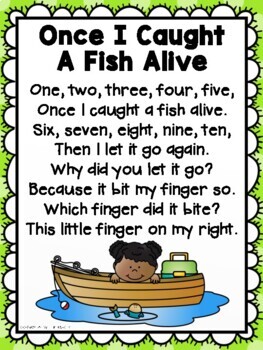

Otherwise, she might have caught the fish and cooked it for dinner. Hence, the speaker remarks the fish bit her finger. As it’s a children’s poem, there should be a funny and naughty twist in the poem. From the previous one anticipates that the speaker was a kind-hearted person. In this section, the speaker asks herself why she let it go to the water. The second stanza of ‘1, 2, 3, 4, 5, Once I Caught a Fish Alive’ nursery rhyme shifts from the activity of counting and talks about the rest of the short tale. They flow separately as if counting numbers is the first activity for the kids and the story comes next as a fun element. Apart from that, the end-stopped refers that the activity of counting and the imaginary story isn’t c onnected. Moreover, the first-person speaker present in the poem gives the rhyme the quality of a lyric poem. In between this, the speaker counts the number up to 10 without breaking the rhythm of the poem. However, in this poem, the narrator tells children a simple story of catching a fish alive and letting it go again in the water. Such a technique eases the burden of learning and makes education a fun-process. Each element goes side by side, be it fun or getting familiar with the numbers. ‘1, 2, 3, 4, 5, Once I Caught a Fish Alive’ nursery rhyme introduces the numbers one to ten in the first stanza innovatively. Moreover, the use of rhetorical exclamation in this stanza levels up the energy of this nursery rhyme.Īnalysis of 1, 2, 3, 4, 5, Once I Caught a Fish Alive Stanza One In the last line, there is a metaphor in the reference to the little finger as “pinky”. One can understand that here the fish is compared to a human being. In the second line, “Because he bit my finger so!” there is personification. In the second stanza, there is a rhetorical question or interrogation in the first line. Here, one can find alliteration in “Six, seven”. Likewise, the third line also contains these devices. Moreover, there is alliteration in “two, three”. It is meant for referring to continuity while counting numbers.

As one can see there isn’t conjunction in the first line. ‘1, 2, 3, 4, 5, Once I Caught a Fish Alive’ nursery rhyme begins with asyndeton. Literary Devices in 1, 2, 3, 4, 5, Once I Caught a Fish Alive The second stanza is composed of iambic trimeter and iambic tetrameter alternatively. The rest of the lines are in iambic tetrameter with the anacrusis in the beginning. In the last two lines, “bite” rhymes with “right”.Īpart from that, the first and third lines of the first stanza contain five stressed syllables. The first two lines of the following stanza end with the rhyming words “go” and “so”. In the first stanza, “five” rhymes with “alive” and “ten” rhymes with “again”. Every two neighboring lines of the poem form a rhyming couplet. Apart from that, the poem contains a regular scheme. There are a total of eight lines in this nursery rhyme whereas the modernized text contains six four-line stanzas. ‘1, 2, 3, 4, 5, Once I Caught a Fish Alive’ nursery rhyme consists of two stanzas each having four lines in it. Structure of 1, 2, 3, 4, 5, Once I Caught a Fish Alive After asking himself/herself to point out the finger, the speaker shows his/her pinkie finger or the little finger of his/her right hand. He/she answers that it bit one of his/her fingers. In the following stanzas, the speaker asked himself/herself the reason behind letting the fish go.

Then counting the numbers five to ten, he/she says that he/she let it go again. Thereafter the speaker informs that once he/she caught a fish alive. ‘1, 2, 3, 4, 5, Once I Caught a Fish Alive’ nursery rhyme begins with the numbers one to five.

‘1, 2, 3, 4, 5, Once I Caught a Fish Alive’ nursery rhyme introduces the numbers one to ten through the story of catching a fish.


 0 kommentar(er)
0 kommentar(er)
